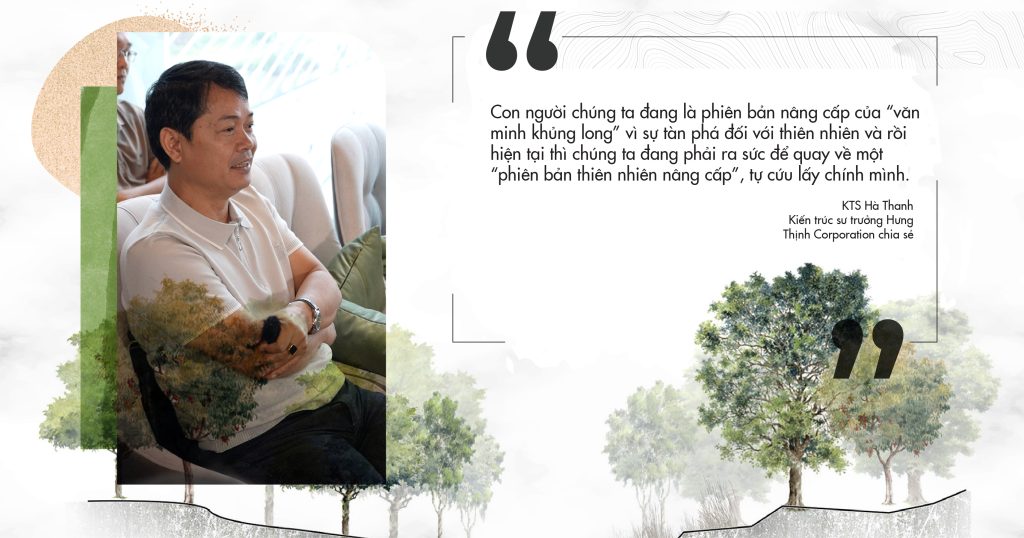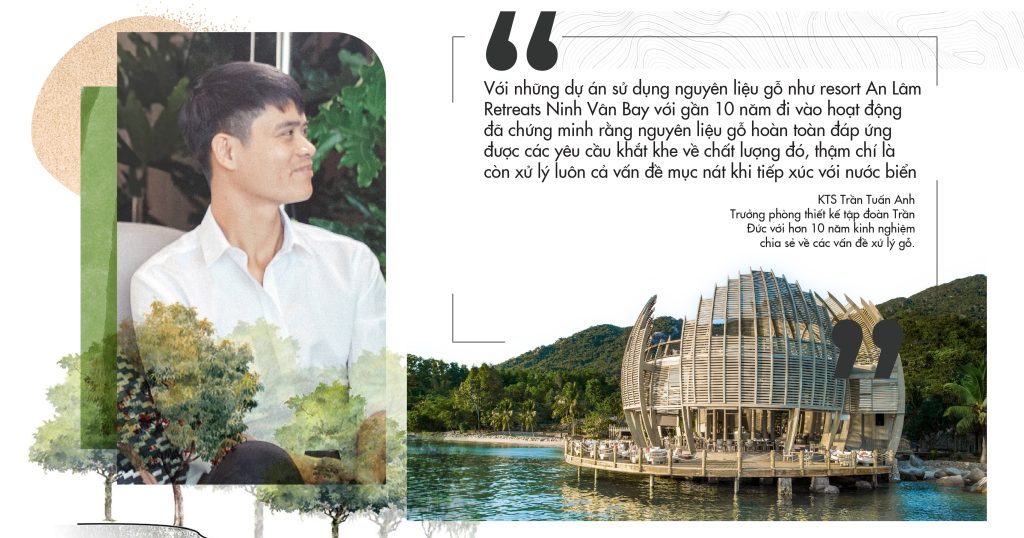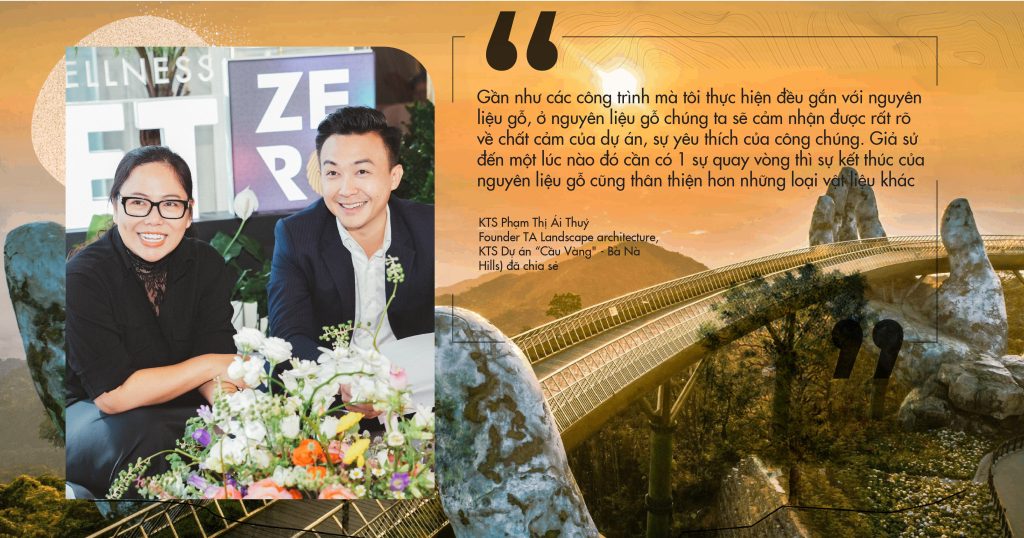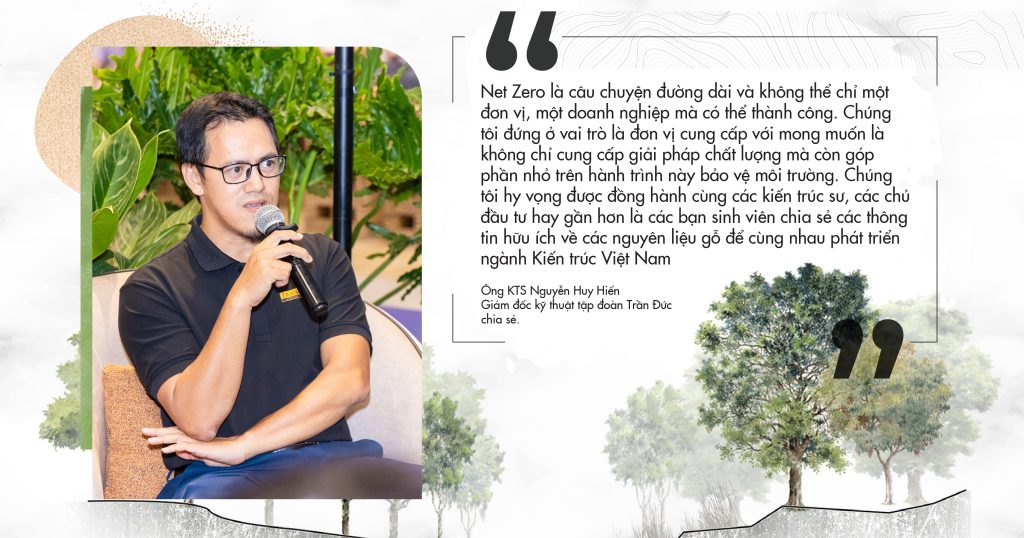

“Vietnam’s Architecture and Construction industry is facing significant opportunities and challenges with the government’s Net Zero 2050 initiative. To realize this goal, all industry personnel, including architects, investors, and engineers, must join hands in action.”
The alarming state of environmental pollution is posing immense challenges for all industries, especially Architecture and Construction. According to the International Energy Agency (IEA), the Construction sector contributes up to 40% of global CO2 emissions. Utilizing green materials with clear origins, capable of replacing traditional concrete and protecting the environment, is the optimal solution to reduce CO2 emissions and embark on a green construction journey.

Wood is one of the materials that meets the most stringent requirements of projects, from public works to residential projects, not only ensuring aesthetic factors and good load-bearing capacity but also fulfilling sustainable and environmentally friendly criteria.
“Why is using wood considered environmentally friendly when logging harms the environment?” This is the most common question when architects approach this material. However, this is a question of the past, as the world has now demonstrated with many wood constructions. “In New Zealand, 67% of forests are sustainably managed. When a tree is felled for construction purposes, another must be planted, ensuring a continuous cycle of wood-forest, which helps absorb carbon and protect the Earth. Wood grown in sustainably managed forests, with government-regulated harvesting plans and FSC certification (ensuring wood products are from controlled sources and comply with environmental, social, and economic standards), will make projects not only aesthetically pleasing but also contribute to environmental protection,” shared Ms. Nguyen Hong Nhung, Trade Development Manager at New Zealand Trade Enterprise.
If wood materials previously raised concerns about defects like warping, cracking, and splitting, the development of the Architecture and Construction industry has now provided solutions to address these issues.

“Warping, cracking, splitting, termites… these are common concerns about wood materials, especially for construction in Southeast Asia’s harsh tropical climate. However, we now have advanced wood processing solutions (Thermo wood modification and H-Grade technology) to resolve these problems. Projects using wood materials, such as An Lam Retreats Ninh Van Bay, which has been operational for nearly 10 years, have proven that wood materials fully meet stringent quality requirements, even addressing decay issues when exposed to seawater,” shared Architect Tran Tuan Anh, Head of Architecture at TranDuc Corporation, with over 10 years of experience in wood processing.
First developed in Austria in the early 1990s, Cross-Laminated Timber (CLT) quickly became a leading sustainable building solution, improving project efficiency while minimizing environmental impact. For example, Brock Commons Tallwood House (Canada), an 18-story building constructed entirely from wood, has become one of the world’s tallest CLT buildings.
In Vietnam, especially in landscape projects, Architect Pham Thi Ai Thuy (Founder of TA Landscape Architecture, Architect of the “Golden Bridge” project in Ba Na Hills) shared, “Almost all countries now use wood structures, especially historical sites and scenic spots, due to its adaptability and environmental friendliness. Nearly all projects I undertake involve wood materials, which bring a distinct sense of project texture and public appreciation. If a circularity is needed, the end of wood materials is also more environmentally friendly than other materials.”

The CLT production line, the first advanced engineered wood solution in Southeast Asia, was launched in late December 2023 under the management of TranDuc Corporation. This is not just a technology but a journey to bring Vietnam’s Architecture and Construction industry closer to the world.
“Net Zero is a long-term story, and no single entity or business can succeed alone. We hope to collaborate with architects, investors, and students to share useful information about wood materials and jointly develop Vietnam’s Architecture industry,” shared Architect Nguyen Huy Hien, Technical Director of TranDuc Corporation.

“Net Zero Roundtable” is the first talk show series on Net Zero in Architecture & Construction, featuring industry professionals such as project directors, technical directors, and specialized media, organized by TranDuc Corporation. At the event, leading architects provided data and information to demonstrate that innovation and creativity in using green materials are key to sustainable development for the future of the Construction industry.
With over 20 years of experience, TranDuc Homes proudly stands as the leading provider of comprehensive solutions for the Architecture and Construction sectors in Southeast Asia. TranDuc Homes is aiming for a future where our solutions not only lead in quality but also pioneer the development of green construction, sustainable living, and environmental protection.
HCM Office:
Unit 901, The Waterfront Saigon, 1-1A-2 Ton Duc Thang, Sai Gon Ward, Ho Chi Minh City, Vietnam.
Factory:
69/13 Binh Chuan 42 Street, Binh Phuoc A Quarter, An Phu Ward, Ho Chi Minh City, Vietnam.
E-Mail: [email protected]
Phone: 0988 897 997